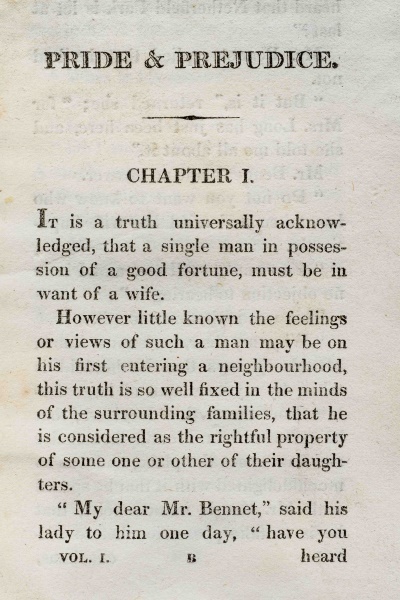Austen: Pride and Prejudice
“It is a truth universally acknowledged, that a single man in possession of a good fortune, must be in want of a wife.”
With this now iconic sentence, Jane Austen began what would become her most successful and most celebrated novel, Pride and Prejudice. The novel, originally composed in 1796-97 with the title First Impressions, was rejected by the London publisher Cadell & Davies sight unseen in 1797. Continuing her work undaunted on other writing projects, Austen “lopt & cropt” the rejected novel, as she told her sister Cassandra in a letter, and the reworked manuscript became Pride and Prejudice. The revised version was published in January 1813 by Thomas Egerton, who purchased the manuscript for £110, less than what Austen had hoped for after the success of her first published novel, Sense and Sensibility.
Pride and Prejudice was advertised as authored by “a Lady, the Author of Sense and Sensibility.” Initially only Austen’s family and a few close friends knew of her authorship. However, the secret was soon out. The first printing of 1,500 copies quickly sold out, and a second edition appeared in November of that same year. The novel received positive reviews in the British Critic, Critical Review, and New Review and was esteemed by Austen’s contemporary authors, in essence launching her career. Austen herself described Pride and Prejudice as “rather too light & bright & sparkling,” perhaps disingenuously, as she also referred to the novel as her “own darling Child.”
The famous first sentence of Pride and Prejudice introduces the reader to Austen’s delightfully ironic tone. The omniscient narrator’s “universal truth” in fact reflects the attitudes of a particular community. It is, of course, women of no fortune who want husbands, not men of good fortune who need wives. Thus Austen pokes fun at the scramble for eligible bachelors in a small village while pointing to the very real economic issues at the heart of marriage inthe late eighteenth and early nineteenth centuries. At a time when gentlemen’s daughters did not work for a living, marriage often provided the only avenue to financial security. Austen’s realistic depiction of economic concerns and her exploration of what constitutes a true marriage are often overlooked in the novel’s modern-day adaptations, which tend to focus on the story’s more romantic elements.
After its initial success, Pride and Prejudice went out of print in the 1820s. The inclusion of all of Austen’s novels in Richard Bentley’s Standard Novels, in 1832- 33, ensured a continuous supply of cheap editions of the novel throughout the nineteenth century, but it was not until the 1880s that critical and popular interest in Jane Austen and Pride and Prejudice significantly revived. This was due to the publication in 1870 of James Edward Austen Leigh’s Memoir of Jane Austen (his aunt) and the 1894 Allen and Macmillan illustrated edition of the novel. While critical interpretation of the novel has varied widely in the last hundred years, Pride and Prejudice’s popularity has never wavered. More adaptations, prequels, and sequels to Pride and Prejudice have been written than for any of Austen’s other novels, and more television and movie adaptations have been made of it than almost all her other novels combined.
—Laura Vorachek, PhD, Associate Professor, English
Excerpt from Jane Austen's "Pride and Prejudice" read by Laura Vorachek, Professor. University of Dayton. Department of English

